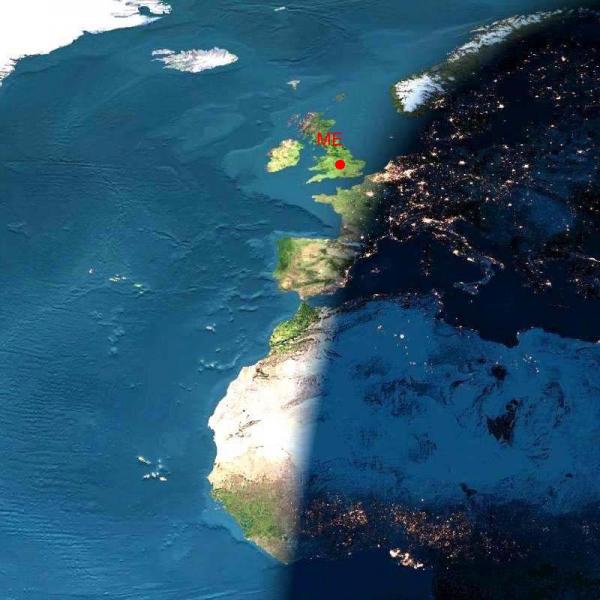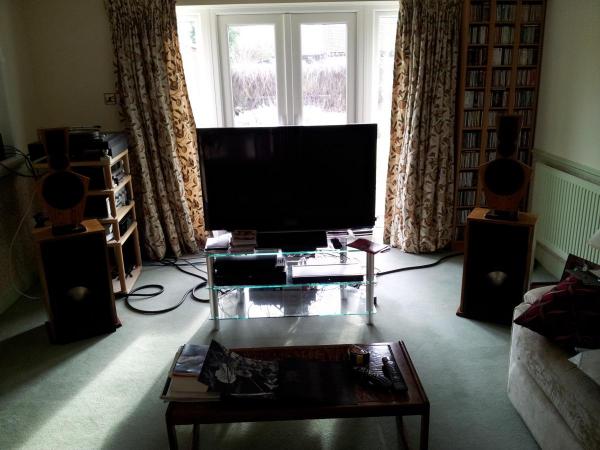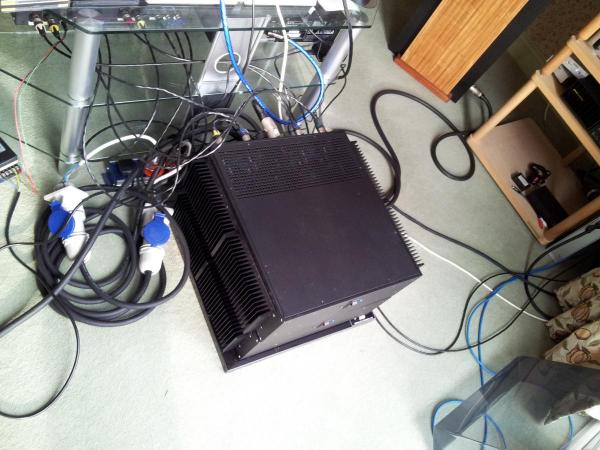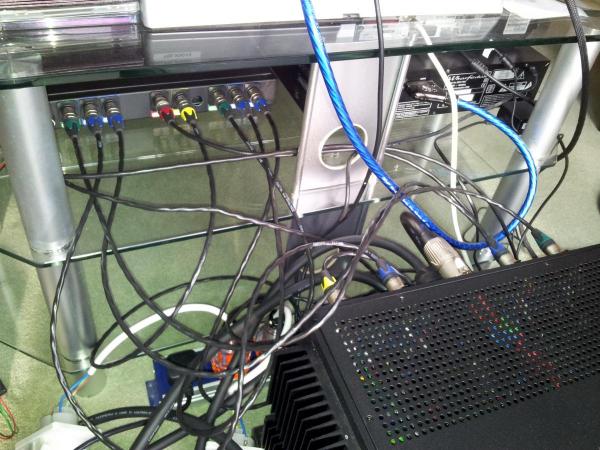-
Posts
5,470 -
Joined
-
Last visited
-
Days Won
33
Content Type
Profiles
Forums
Events
Everything posted by Craig Sawyers
-
Basically it is all down to RFI control - both into and out of the connected equipment. Works from around 100kHz up to 1GHz and more, and has an attenuation (in EMC lab conditions) of up to 40dB as compared with a kettle lead. Oh and there are no ferrites, which themselves are non-linear and generate harmonics, and no series components either. Works mainly in differential mode, but also has a useful effect in common mode too. Basic rationale is that the mains environment is exceptionally noisy now. Cheap switched mode supplies in fluorescent, LED lighting and CFL's, networking over power, which is now squirting 100-300MHz straight into the domestic wiring at watt and several watt levels with a range of 300 metres, and wifi, cell phones, digital cordless phones etc which all couple into the mains wiring. Once that garbage gets into a piece of audio equipment it gets rectified in semiconductor junctions. How bad is the effect? Well at the extreme end, when your cell phone cranks up the power to locate a cell, we'll all have heard zzt-zzt-zzt from an audio system (even broadcast audio) - and that is high hundreds of MHz getting rectified in your 20Hz to 20kHz audio system. Problem is also that that conventional power filters (like the ones on the back of IEC connectors) are only required to be good to 30MHz, and that is where the specs stop. After which they can actually increase the signal level as the multiple components in there go into self-resonance. Only reason I rolled over on a low royalty (about £30 per cable) was that it will launch in the US directly from Ray Kimber sometime this year, so the market should go up significantly as compared to just the UK. Only a very few (one or two) of the silver variety sell each year over here, which is kind of not surprising. I'm not about to get rich quick with this for sure.
-
Oh dear. Time to fess up. The SD in the cable mentioned above stands for Sawyers Disc. Which is moi. I get a piss poor royalty for every one sold.
-

The Knuckledragger 3rd Memorial Slow Forum Post
Craig Sawyers replied to Knuckledragger's topic in Off Topic
^^ The Shambles, York UK -

The Knuckledragger 3rd Memorial Slow Forum Post
Craig Sawyers replied to Knuckledragger's topic in Off Topic
^^pre-marinated bacon -

The Knuckledragger 3rd Memorial Slow Forum Post
Craig Sawyers replied to Knuckledragger's topic in Off Topic
I was attacked by a pheasant yesterday. I kid you not - I was out walking, and in the middle of nowhere I saw this cock pheasant strutting around. Really nice looking bird so I stopped. He came closer and closer until he was just an inch or two from my foot. Anyway, I walked on, and the damned bird followed me, paralleling the path. After about 400 yards it attacked me! Must have been on its territory, but it is way outside breeding season. I kicked it and it had another go. Kicked it again - no luck the damned bird came on. Eventually I too a real soccer kick at it, and it decided I was going to fight back and gave up. Forget the parrot, try taking on something the size of a pheasant! At 0 degrees C. -

The Knuckledragger 3rd Memorial Slow Forum Post
Craig Sawyers replied to Knuckledragger's topic in Off Topic
-

The Knuckledragger 3rd Memorial Slow Forum Post
Craig Sawyers replied to Knuckledragger's topic in Off Topic
I have no idea where you get these images Knucks, and I really don't care. This sir is a plain and simple a fucking fantastic thread. -
Shit. Apart from the MPSW transistors we're talking about here, ONsemi were one of the major suppliers of TO92 packaged transistors. It does make you wonder whether they engineered the disagreement with their packagers because of a strategic decision to move to SM
-
More background, after Magnets Bulbs and Batteries. I got interested in audio at about age 15 or so, having been given a record player at age 13 (with vinyl-clashing autochanger) and was not that satisfied with it. Not having much money, I walked into J G Windows music and hifi store in Newcastle on Tyne (UK) and asked if they had any Saturday jobs. Still there, and doing the same sort of stuff http://www.jgwindows.com/pages/Contact-Newcastle.html. It turned out yes they did have a place for a Saturday lad, so I got my very first paid job in 1972 (oddly enough the same year that NAD - New Acoustic Dimension started in business), My job was selling hifi gear, which I was not too shabby at. But the really big advantage was that I could buy anything in the shop at cost price - so a third off. Hifi gear, records, televisions, musical instruments. It was at that time I bought my Thorens TD150 (still have it, 42 years on) and SME 3009 pickup arm (still have it). Bought lots of records, from Classical to heavy metal and everything between. I built my own amp and speakers. That rig went through my entire university life with me and did not miss a beat. But in my first year, I was in digs (ie living in someone elses house for money) and thought I'd better get a pair of headphones, and found a pair of Koss PRO4AA second hand in a local shop (now in Southampton). They were very good, with fluid filled ear pads - but they were crushingly heavy and it felt like you head was in a vice. Eventually I upgraded to a (second hand) pair of Koss ESP6 electrostatics. They were a real revelation in clarity, but boy oh boy were they heavy. The HV and step up transformers were in the earcups, and fluid filled ear pads again - you needed total dedication to wear them. I went through several different loudspeaker/amp combinations, going active at one stage with the first of Linkwitz's designs, but using transmission line bass units - this in 1978-ish. But my move to high-end came at an audio show in London (the Heathrow Penta show) in maybe 1985. I walked into the Meridian room - and Meridian at that time were importers of Mark Levinson. So they had their CD player into a dual mono ML with external power supply, into ML class A monoblocks and Quad ESL63's on stands. They were playing Brothers in Arms, something I knew very well. It sounded like a completely different piece of music! At the time I was using the first generation Philips CD player, the TD150 etc into a Quad 34 pre and 405 power amp and a pair of KEF speakers - but the Meridian room totally and utterly demolished it sonically. I just HAD to have something that came close. So I've been though Krell, Audio Research, Magnaplanar, Martin Logan, Podium, Quad ESL57 over the years, and have now settled on homebrew power amps (8 channels) and active LX521's - by Linwitz. And there it is going to stay apart from inevitable tweaks for a good long time (knock on wood!).
-
This community amazes me. The USSR and now India!
-

The Knuckledragger 3rd Memorial Slow Forum Post
Craig Sawyers replied to Knuckledragger's topic in Off Topic
<breathless> -
Real bacon from a pig, and real turkey together in a sandwich is a fine thing. But TurkeyBacon
-

Shave-Case: The official HC hair removal thread.
Craig Sawyers replied to Knuckledragger's topic in Miscellaneous
Well thread this is a new discovery! I've gone back to fundamentals to an extent over the last year. I too use Sandalwood soap (Mrs S likes the smell, and who am I to deny her?), the soap block not the cream. One block lasts about a year. I buy my stuff from this outfit http://www.theenglishshavingcompany.com/any/Edwin-Jagger/. Silver tipped badger brush. Although I use one of their shaving blade handles, it is one that takes Gillette Mach3 refills. Like this Never ever have a rash, and almost never have a cut (and that is only when I lose concentration. -

The Knuckledragger 3rd Memorial Slow Forum Post
Craig Sawyers replied to Knuckledragger's topic in Off Topic
Good god it eats engines too. -
At the back end of last year I was on business in the United Arab Emirates, in Abu Dhabi. You could not get real bacon at breakfast (a Muslim thing regarding the pig), and only Turkey Bacon was available. It was I am afraid totally awful, tasteless stuff with the consistency of slices of paste. It was so awful that I defaulted to having a can of beer nuts from the room for breakfast instead.
-
Ah - the Mercury Living Presence recording. Antal Dorati conducting the London Symphony Orchestra. Still awesome even now (I have the CD, not the black vinyl). Sleeve notes say it was two 6lb smooth bore bronze cannons and a 12lb Howizer, from West Point, and fired under the direction of Gerald C Stone by the reactivated Civil War Unit, Battery B, 2nd New Jersey light artillery. The CD has a demo of the recording technique with a voiceover. So yes, real audiophile cannons for sure!
-
Um - interesting. I took Oz in his profile as the short form for Australia! If he is in Texas, there are far more auditioning options.
-
Have a look at the website devoted to builders of Linkwitz's designs http://orion.quicksytes.com/. There is a thread devoted to finding people who have built the thing and are prepared to invite others to have a listen. Now you're in Oz, which is a big place (32 times the area of the UK, and bigger than the US if you leave off Alaska), so finding a builder withing striking distance might be tricky. Aha - there is someone in Adelaide with LX521 http://orion.quicksytes.com/viewtopic.php?f=28&t=2787 But the latest design is called the LX-Mini, is built from bits of drainpipe (I kid you not) and all in - drivers, DSP crossover, power amps etc - should cost under a grand (Euros or UK pounds). In fact a kit (minus DSP and power amps) is available from http://www.magiclx521.com/news.htmlfor Euro 499 plus Euro 78 shipping to Australia *including* the drivers. When the Mini and the LX521 have been reviewed at audio shows, the Mini has all the sonic characteristics of the LX521 but with less bass. When you consider the price is about a quarter of an LX521 system it is so worth a punt The *drivers* for the LX521 cost more than a complete LX mini system!
-
You must've filled up his senses, Tice
-
This is a news story even in the UK - so it looks like a big one. Stay safe if you are in the path of the blizzard coming in.
-
Thanks for the kind comments folks! The good news is that it passed the wife test. That she likes the look of these is more a statement of what outrageous speakers I've inflicted on her over the years. But even better she is blown away, in her own terms, by the sound quality "It sounds so involving - you just get drawn into the music". If it had sounded like a bag of hammers she'd certainly have said so . I remember a couple of years ago I hauled her along to an audio show in London - a showcase for British high end. Anyway, we walked into some room or other, and they were playing a Marc Cohn track that we know very well. I did sound absolutely dire (a mate describes that effect as being like having the back of your eyeballs scratched), but Carole started to laugh out loud - I had to shoo her out with the comment that the guys in the room had actually worked very hard to design a product that sounded so awful, and were cloth eared enough not to notice, and you had to respect that particular talent with quiet decorum.
-
Got the LX521's fired up. Apart from a temporary hum problem, everything connected up and worked right off. I honestly have heard nothing remotely like them. The first thing that hits you is the imaging (or "phantom acoustic scene" as Linkwitz terms it). They are twitchy regarding positioning - I was underwhelmed first off until I used a tape measure to set them equally from side and end wall, and then frigged a little with toe in. At which point I've spent 4 hours having my socks blown off. They are punishingly neutral, to the extent that truly great recordings sound awesome, and ones that are poorly recorded sound desperately bad - like having a camera into the the head and stone deafness of the recording engineer. Mind you, I overdid the amp heatsinks - they got slightly tepid after four hours solid at pretty high listening levels. All interconnections are balanced, and colour coded throughout to prevent something dumb (like putting the bass output through the tweeter). Amp to speakers is an 8-pole speakon, for the same reasons - regular speaker connectors offer too many possibilities for getting it wrong.
-
Aagh - what a nightmare, Peter. Fingers well and truly crossed for insurance stepping up to the plate






